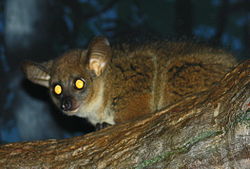Prosimian
Prosimians are a group of proto-primates. It includes: 1. All living and extinct strepsirrhines (lemurs, lorises, and adapiforms),[4] and 2. haplorhine tarsiers and their extinct relatives, the omomyiforms.
| Prosimian |
|---|
 |
| Scientific classification |
|
|
| Included groups |
| Cladistically included but traditionally excluded groups |
All of them have characteristics that are more "primitive" than simians (monkeys, apes, and humans).[4] On the other hand, they have survived. Therefore we know that their life-style is not directly competitive to that of the higher primates.
First, they are primarily carnivorous. They mainly eat insects, not fruit. They lack full colour vision: they are red-green blind (cannot see the difference between red and green). This has a corresponding advantage in that they can see better in the dark. This is also true of many placental mammals, and for the same reason. Mammals spent long periods as nocturnal animals during the Jurassic and Cretaceous periods.
Prosimians are not a clade (a group of an ancestor and all its descendants), but a convenient term. It is useful to compare their behaviour with that of later primates. Prosimians are not large-brained compared to other placental mammals. They are fairly intelligent animals. However, their brains are much smaller than those of simians of similar size.
Prosimians are the only primates native to Madagascar, and are also found throughout Africa and in Asia.
Prosimian Media
The tapetum lucidum of a galago, typical of prosimians, reflects the light of the photographer's flash.
References
- ↑ Szalay & Delson 1980, p. 149.
- ↑ Cartmill 2010, p. 15.
- ↑ Hartwig 2011, pp. 20–21.
- ↑ 4.0 4.1 Whitten P.L. & Brockman D.K. 2001. (2001). "Chapter 14: Strepsirrhine reproductive ecology". In Ellison, P. T (ed.). Reproductive ecology and human evolution. Transaction Publishers. pp. 321–350. ISBN 978-0-202-30658-2.
Notes
- ↑ Although the monophyletic relationship between lemurs and lorisoids is widely accepted, their clade name is not. The term "lemuriform" is used here because it derives from one popular taxonomy that clumps the clade of toothcombed primates into one infraorder and the extinct, non-toothcombed adapiforms into another, both within the suborder Strepsirrhini.[1][2] However, another popular alternative taxonomy places the lorisoids in their own infraorder, Lorisiformes.[3]
